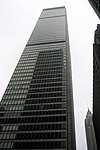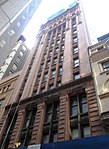Financial District, Manhattan

The Financial District of Lower Manhattan, also known as FiDi, is a neighborhood located on the southern tip of Manhattan island in New York City. It is bounded by the West Side Highway on the west, Chambers Street and City Hall Park on the north, Brooklyn Bridge on the northeast, the East River to the southeast, and South Ferry and the Battery on the south. The City of New York was created in the Financial District in 1624, and the neighborhood roughly overlaps with the boundaries of the New Amsterdam settlement in the late 17th century. The district comprises the offices and headquarters of many of the city's major financial institutions, including the New York Stock Exchange and the Federal Reserve Bank of New York. Anchored on Wall Street in the Financial District, New York City has been called both the most financially powerful city and the leading financial center of the world, and the New York Stock Exchange is the world's largest stock exchange by total market capitalization. Several other major exchanges have or had headquarters in the Financial District, including the New York Mercantile Exchange, NASDAQ, the New York Board of Trade, and the former American Stock Exchange. The Financial District is part of Manhattan Community District 1, and its primary ZIP Codes are 10004, 10005, 10006, and 10038. It is patrolled by the 1st Precinct of the New York City Police Department.
Excerpt from the Wikipedia article Financial District, Manhattan (License: CC BY-SA 3.0, Authors, Images).Financial District, Manhattan
Chase Manhattan Plaza, New York Manhattan
Geographical coordinates (GPS) Address Nearby Places Show on map
Geographical coordinates (GPS)
| Latitude | Longitude |
|---|---|
| N 40.7075 ° | E -74.009166666667 ° |
Address
Sunken Garden
Chase Manhattan Plaza
10045 New York, Manhattan
New York, United States
Open on Google Maps











